
The canton of Uri is one of the 26 cantons of Switzerland and a founding member of the Swiss Confederation. It is located in Central Switzerland. The canton's territory covers the valley of the Reuss between the St. Gotthard Pass and Lake Lucerne.

Altdorf is a municipality in Switzerland. It is the capital of the Swiss canton of Uri and retains historic town privileges. It is the place where, according to the legend, William Tell shot the apple from his son's head.
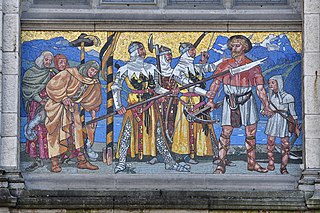
William Tell is a folk hero of Switzerland. According to the legend, Tell was an expert mountain climber and marksman with a crossbow who assassinated Albrecht Gessler, a tyrannical reeve of the Austrian dukes of the House of Habsburg positioned in Altdorf, in the canton of Uri. Tell's defiance and tyrannicide encouraged the population to open rebellion and a pact against the foreign rulers with neighbouring Schwyz and Unterwalden, marking the foundation of the Swiss Confederacy. Tell was considered the father of the Swiss Confederacy.

The Old Swiss Confederacy began as a late medieval alliance between the communities of the valleys in the Central Alps, at the time part of the Holy Roman Empire, to facilitate the management of common interests such as free trade and to ensure the peace along the important trade routes through the mountains. The Hohenstaufen emperors had granted these valleys reichsfrei status in the early 13th century. As reichsfrei regions, the cantons of Uri, Schwyz, and Unterwalden were under the direct authority of the emperor without any intermediate liege lords and thus were largely autonomous.

Albrecht Gessler, also known as Hermann, was a legendary 14th-century Habsburg bailiff at Altdorf, whose brutal rule led to the William Tell rebellion and the eventual independence of the Old Swiss Confederacy.
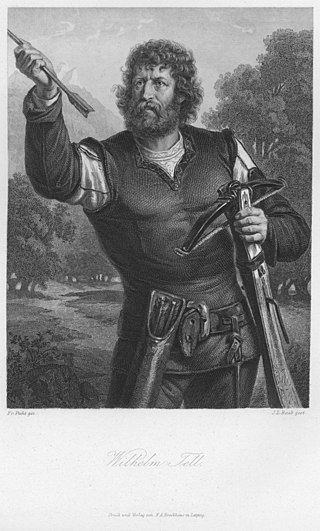
William Tell is a drama written by Friedrich Schiller in 1804. The story focuses on the legendary Swiss marksman William Tell as part of the greater Swiss struggle for independence from the Habsburg Empire in the early 14th century. Gioachino Rossini's four-act opera Guillaume Tell was written to a French adaptation of Schiller's play.
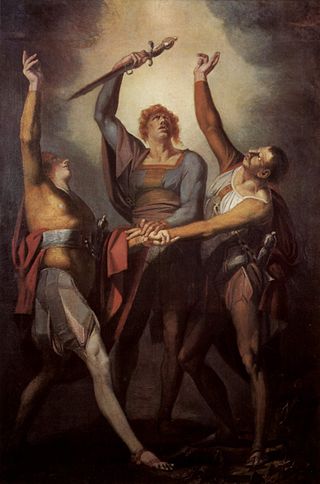
The Rütli Oath is the legendary oath taken at the foundation of the Old Swiss Confederacy by the representatives of the three founding cantons, Uri, Schwyz and Unterwalden, It is named after the site of the oath taking, the Rütli, a meadow above Lake Uri near Seelisberg. Recorded in Swiss historiography from the 15th century, the oath is notably featured in the 19th century play William Tell by Friedrich Schiller.

Rütli or Grütli is a mountain meadow on Lake Lucerne, in the Seelisberg municipality of the Swiss canton of Uri. It is the site of the Rütlischwur in traditional Swiss historiography, the oath marking the foundation of the original Swiss Confederacy. As such it is treated as a national monument of Switzerland. Since 1860, the Schweizerische Gemeinnützige Gesellschaft (SGG) has organized a celebration at the site on Swiss National Day, since 1994 recognized as a public holiday. Rütli is only accessible by boat from Lake Lucerne or by foot from Seelisberg.

Richard Kissling was a Swiss sculptor, and medallist.
The Bundeslied or Tellenlied is a patriotic song of the Old Swiss Confederacy. Its original composition dates to the Burgundian Wars period (1470s). The oldest extant manuscript text was written in 1501, the first publication in print dates to 1545. It consists of stanzas of six lines each, with a rhyming scheme of A-A-B-C-C-B. It is one of the oldest existing records of the legend of Swiss national hero William Tell.

A shooting thaler is a silver coin in thaler size minted to commemorate a Schützenfest or free shooting in Switzerland.
Mario Bernasconi was a Swiss-Italian sculptor.

Flüelen railway station is a railway station in the Swiss canton of Uri and municipality of Flüelen. It is located on the Gotthard railway. The station is situated between the parallel Axenstrasse, the main road through Flüelen, and Bahnhofstrasse, with the main station buildings on Bahnhofstrasse.
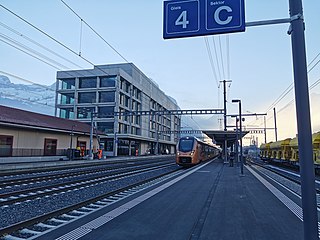
Altdorf railway station is a railway station in the Swiss canton of Uri and municipality of Altdorf. The station is situated on the Gotthard railway north of its crossing of the Alps, and is the most southerly station before that line splits into the older route via Erstfeld and the original Gotthard Tunnel, and the newer route via the Gotthard Base Tunnel. The station was reconstructed between 2019 and 2021.
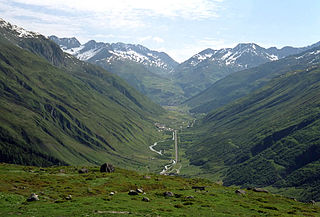
Uri is a Swiss Talschaft and canton in the upper Reuss valley.

Lukas Ferdinand Schlöth was a Swiss sculptor in the late Classical style.

The Stauffacherin is a Swiss legendary figure. According to Swiss folklore, she was the wife of Werner Stauffacher, the Landammann of the Canton of Schwyz and a founding father of the Old Swiss Confederacy. She was depicted in Friedrich Schiller's 1804 play William Tell as an advisor to her husband, advocating for Swiss independence from Habsburg rule. The image of the Stauffacherin, often viewed as the feminine counterpart to Wilhelm Tell, has become a symbol for Swiss national pride, democracy, and women's suffrage.

The Winkelried memorial was erected in memory of Arnold von Winkelried, who sacrificed his life in the Battle of Sempach on the 9 July 1386. According to the Swiss historiography, the Swiss wouldn't be able to break through the firmly positioned order of Habsburg pikemen. At a moment, Winkelried decided to throw himself into the pikes and therefore open a passage through the Austrian defensive front, which made way for an attack of the Swiss confederacy which then led to a Swiss victory in the Battle of Sempach.

The Strassburger memorial is a monument in Basel established in memory of the help the civil population of Strassburg received from Switzerland during the Franco-Prussian war in 1870–1871. It was modeled by Frédéric Auguste Bartholdi and is located in a park across from the Basel railway station.

Heinrich Max Imhof was a Swiss sculptor, in the Classical style. Max may be short for either "Maximilian" or "Maximus".


















